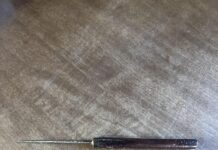
When we think of trumpeter swans, we picture beautiful, white birds floating gracefully on the water. We don’t think of them being hunted relentlessly, or their feathers — and especially their skins — marketed commercially. But that’s what was most responsible for their near disappearance in the lower 48 states.
Beginning in the 1600s, trumpeter swan feathers were used to decorate hats and clothing, and their flight feathers for quill pens. Their skins lined vests, coats and ceremonial robes and were used to make vests, caps and wallets. Since it is soft and chamois-like, one of the most popular uses of swan skin was to make powder puffs.
Though mostly known for marketing beaver, muskrat and other skins, the Hudson Bay Company sold more than 108,000 swan skins in London between 1823 and 1880. Most of these came from trumpeter swans, but some were from tundra swans. They were also disappearing from their range in North America including, ironically, the Hudson Bay.
In 1736, quill pens made mostly from trumpeter swan feathers began to be sold in London in bundles of 25 or 100; more than 1.2 million quills from both swans and geese were sold there in 1837 alone. Historians say 10 quills were harvested from each bird for this purpose, so at least 100,000 swans and geese were required to make that number of pens.
The National Park Service began a survey of trumpeter swan populations on park lands in 1929. Three years later, they had found only 31 in Yellowstone and 38 on Red Rock Lakes and surrounding areas of Montana.
Reintroduction

Except for some that stopped over during migration, trumpeter swans had disappeared from Ohio by the early 1700s, said Laura Kearns, wildlife biologist with the Ohio Division of Wildlife. In 1996, Ohio joined other midwestern states in starting a reintroduction program. That year, the first trumpeter swans were released in Magee Marsh along the Lake Erie shore.
In the next several years, more than 150 were released there and in other parts of the state. Some of the releases were the result of division personnel collecting 50 eggs from trumpeter swan nests in Alaska. The eggs were hatched at the Cleveland Metroparks Zoo, and then sent to The Wilds in Muskingum County and raised till they were 2 years old.
Others were parent-raised swans from private propagators in Ohio, Wisconsin or New York. They were kept at The Wilds until mature and then released in other parts of the state. The last group, from the Kellogg Bird Sanctuary in Michigan, was released directly from The Wilds and spread into surrounding areas.
The reintroduction program ended in 2003, earlier than expected, because the goal of 15 breeding pairs had been met and the populations of reintroduced birds had become self-sustaining, Kearns said.
In 2013, the trumpeter swan was listed as “threatened” instead of “endangered” in Ohio. Last year, there were 111 breeding pairs in the state, while the number of cygnets, or offspring, was at an all-time high of 206.
Magee Marsh is recommended as one of the best places to view trumpeter swans, but so are the Ottawa National Wildlife Refuge and Killdeer Plains, Shenango and Big Island wildlife areas.
“The populations are self-sustaining, which is what we prefer,” Kearns said. “It’s a great success story.”
She gets what is perhaps the best view of that success story.
Kearns, another biologist and a Division of Wildlife helicopter pilot spend several days in July flying over wetlands and other potential breeding sites. The three of them count all the adult trumpeter swans, breeding pairs and cygnets that they see.
“Fortunately they’re big and white,” Kearns joked. “But when they have young, they’ll hunker down under vegetation and trees, so you have to be very attentive to spot them.”
“Big” an understatement

With a wing span of seven feet and weight upwards of 25 pounds, trumpeter swans are North America’s largest flying bird. Their long necks allow them to access food in deeper water than other waterfowl; they can upend and uproot plants in four feet of water.
Their weight, and the fact that their short, black legs are behind their center of gravity, causes them to run on the surface of the water for at least 100 yards before they become airborne. But those short legs can carry them a mile or more on land, where they often feed in farm fields during the winter.
Breeding in Ohio peaks in April and the young hatch in June. The average is five eggs but there can be as many as nine. Trumpeter swans have an unusual way of incubating the eggs, warming them with their webbed feet.
The cygnets remain with their parents through the summer and migrate with them in October and November. They migrate with their parents back to breeding grounds in spring but are usually chased away by adults when they’re about a year old.
They remain in sibling groups till age 2 and then begin to seek mates. When they do pair up, trumpeter swans stay together throughout the year, even during migration. Although some may change partners, it’s assumed that most mate for life.
Trumpeter swans must worry about predators that might eat both their eggs and cygnets. Those include the usual mammals like raccoons and coyotes, but can also be snapping turtles and birds of prey.
Trumpeters have been known to fight for their young, whacking intruders with their powerful wings. Limiting predator access seems to be a motive in choosing nest sites, which are often offshore in shallow water. They like to build on muskrat lodges and beaver dams, so overhunting of these species in the past probably helped with the trumpeters’ decline.
Both the males and females collect plant material for a foundation, topped by a mound of aquatic vegetation. The female uses her bill and body to create a “bowl” that sometimes includes feathers. The swan pair may use the same nest site year after year.
Identification
Though the trumpeter is much bigger than other swans, like the tundra, it’s sometimes difficult to tell them apart from a distance. According to the Trumpeter Swan Society, identification may come down to the beak.
The trumpeter’s beak is black and comes straight off the head. The black coloring extends above the beak and goes all the way to the eyes, making them almost indistinguishable. From the top, the black forms a V shape. But a closer look reveals the beaks of all trumpeters are not entirely black.
“The lower beak often has this pinkish mark, which we call the lipstick grin,” Kearns said.
Though grayish-brown as youngsters, trumpeter swans are pure white as adults. However, in parts of Ohio, their feathers might look like they could use some bleach. There can be rust-colored staining on their heads and necks, which comes from iron and tannins in the water. Tannins come from plant tissue and occur in the roots, bark, leaves and fruit of many trees.
“Most trumpeter swans in Northwest Ohio are feeding in those kinds of waters, so most will have those stains,” Kearns said.
Reintroduction was not the only reason for Ohio’s trumpeter swan success story, she said. It would not have been possible without intensive efforts by the Division of Wildlife and its partners to restore and improve wetlands and to control invasives.
The invasives include noxious plants like phragmites — which can grow 15 feet tall — purple loosestrife and flowering rush. They destroy the diversity of native plants and create a “monoculture,” leaving not only birds but mammals without food and habitat, Kearns explained.
Invasive swan
Perhaps even more of a threat to the trumpeters is an invasive swan. The mute swan is smaller and its neck is a bit shorter and more curved. But again, it’s difficult to tell them apart until you get to the mute swan’s bill, which is bright orange with a large, black knob at the base.
“You also have to listen,” Kearns said. “The trumpeter swan was so named for its loud call. The mute doesn’t have much of a call. It’s more of a growl.”
Mute swans were imported from Eurasia as “decorative waterfowl” in the late 1800s. Though many had their wings clipped to keep them in place, they eventually escaped or were allowed to fly free. They now have populations in all four major flyways in North America.
The mutes go for the same kind of nesting habitat as the trumpeters. Once there, they don’t move much and eat huge amounts of aquatic vegetation, at least eight pounds a day.
In high concentrations, the mutes mess up plant diversity, fish populations, water quality and food supplies for other waterfowl. They are also extremely aggressive in defending their territory. They’ll not only attack trumpeter swans but ducks and other kinds of waterfowl, even mammals.
The Division of Wildlife’s mute swan management plan says they’ve been known to kill other species and their young, and to attack people while they’re boating, which raises the danger of drowning.
The goal of the management plan is to have zero mute swans on public land and zero population growth in other locations, Kearns said. Sometimes this is achieved by killing adults, but often it just involves addling their eggs. By shaking the eggs without breaking the shells, it prevents them from hatching.
“But the adults think they’re okay so they keep sitting on them,” she said. “Otherwise they’d build another nest and lay more eggs.”
Reintroduction and management programs have increased trumpeter swan populations in other parts of the Midwest and other states where they had all but disappeared. There are now more than 30,000 trumpeter swans in Minnesota alone.
“It’s definitely one of Ohio’s success stories,” Kearns said. “But it’s one of the country’s conservation success stories as well.”












Since when did the Department of Wildlife start caring about relocating Trumpeter Swans. A few years back the Ohio Division of Wildlife in Ohio killed off the Trumpeter Swans at Lake Logan, Hocking County Ohio. We were all so irrrate at the time. Why did they not just locate them then?
I checked with the Division of Wildlife and they assured me the operation at Lake Logan was removal of mute swans, not trumpeters.
Very informative article! I wanted to learn about Trumpeter swans as I just spotted a pair on a larger lake in Northeast Stark county. Hope they stay and nest. I was especially glad to learn the dramatic differences between the trumpeter and the less desirable mute swan. The pair I saw were definitely trumpeters!